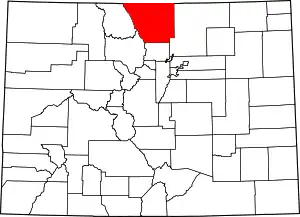Laporte, Colorado
Laporte (also spelled LaPorte, but never La Port) is an unincorporated town, a post office, and a census-designated place (CDP) located in and governed by Larimer County, Colorado, United States. The CDP is a part of the Fort Collins, CO Metropolitan Statistical Area. The Laporte post office has the ZIP Code 80535.[3] At the United States Census 2010, the population of the Laporte CDP was 2,450, while the population of the 80535 ZIP Code Tabulation Area was 2,636 including adjacent areas.[4]
Laporte, Colorado | |
|---|---|
 Laporte, looking west along U.S. Route 287. | |
 Location of the Laporte CDP in Larimer County, Colorado. | |
 Laporte Location of the Laporte CDP in the United States. | |
| Coordinates: 40°38′19″N 105°08′40″W[1] | |
| Country | |
| State | |
| County | Larimer County |
| Settled | 1844 |
| Government | |
| • Type | unincorporated town |
| Area | |
| • Total | 6.224 sq mi (16.120 km2) |
| • Land | 6.116 sq mi (15.841 km2) |
| • Water | 0.108 sq mi (0.279 km2) |
| Elevation | 5,105 ft (1,556 m) |
| Population (2010) | |
| • Total | 2,450 |
| • Density | 401/sq mi (155/km2) |
| Time zone | UTC-7 (MST) |
| • Summer (DST) | UTC-6 (MDT) |
| ZIP Code[3] | 80535 |
| Area code(s) | 970 |
| GNIS feature[2] | Laporte CDP |
History
The town was first settled by French-Canadian fur trappers and mountain men. It was the gateway to all the mountainous region lying north of the South Platte River and extending from the Plains to the Continental Divide. The trappers built cabins here along the Cache la Poudre River as early as 1828, making it the first white settlement in Larimer County. According to legend, a group of fur traders had earlier stashed supplies (including gunpowder) in a cache along the river near Laporte, and that is how the river got its name. It became the home of Antoine Janis in 1844, who is often noted as the first permanent white settler north of the Arkansas River. A band of mountaineers, hunters and trappers made LaPorte their headquarters for fur catching and trading operations. The settlement increased in numbers, including 150 lodges of Arapaho Indians who settled peacefully along the river and in the valley.[5] The town was named by the fur trappers, many with Native American wives, who settled in the area in the mid-19th century. The name la porte means "the door" in French.[6]
The winter of 1849 brought Kit Carson and his company of trappers to the Cache la Poudre, where they set up camp. In 1860 a town company was organized, originally called "Colona". Between fifty and sixty log dwellings were erected that year along the banks of the Cache la Poudre River in the valley, and in November 1861 the territorial legislature designated Laporte as the county seat. In 1862, the town of Colona changed its name to "LaPorte", and was named the headquarters of the Mountain Division of the Overland Trail Stage Route. The first post office opened, and a stage stop was built on the Overland Trail. A station was erected right along the river, very near where the present Overland Trail crosses the river. Mrs. Taylor, wife of the first stationmaster, was a "good cook" and "gracious hostess", and as described by one diarist, knows "what to do with beans and dried apples." The stage fare from Denver to LaPorte was $20.00. The first bridge over the Cache la Poudre River was built as a toll bridge, and during the rush to California, numerous wagons and stage coaches crossed it every day. The toll charged was anywhere from $.50 to $8.00, depending on what source of information is used. In 1864, the bridge was washed away by a flood, and a ferry was rigged up and used for several years until the county built another bridge.
LaPorte soon became a bustling business and supply center for emigrants, with wagon trains and stagecoaches constantly passing through. There were four saloons, a brewery, a butcher shop, two blacksmith shops, a general store and a hotel. The store was a thriving business, sometimes making as much as $1,000 per day. LaPorte was the most important settlement north of Denver, housing the stage station, the county court house, the military, Indians, and trappers. In 1862, Camp Collins was established by the U.S. Army along the river to protect the stage line from attack by Native Americans. Also that same year, the Laporte Townsite Company claimed 1,280 acres (5.2 km2) of land for the town. In 1863 the 13th Kansas volunteer infantry was stationed to Laporte, acting as escort for the Overland Stage on the trail to Virginia Dale. During the flood of 1864, the army camp was covered with water, and the soldiers had to suddenly flee to higher ground. In August of that year, Col. Collins came down from Laramie, Wyoming, on an inspection tour, and decided to move the army camp to Fort Collins, downriver about 6 miles (10 km).[5]
Geography
Laporte is located on the Cache la Poudre River northwest of Fort Collins, close to where the river emerges from the foothills of the Rocky Mountains. U.S. Route 287 runs along the northern edge of the community, leading southeast 6 miles (10 km) to Fort Collins and northwest 58 miles (93 km) to Laramie, Wyoming.
The Laporte CDP has an area of 3,983 acres (16.120 km2), including 69 acres (0.279 km2) of water.[1]
Demographics
The United States Census Bureau initially defined the Laporte CDP for the United States Census 2000.
| Year | Pop. | ±% |
|---|---|---|
| 2000 | 2,691 | — |
| 2010 | 2,450 | −9.0% |
| 2020 | — | |
| Source: United States Census Bureau | ||
Fiction
In L. Neil Smith's North American Confederacy series of novels, beginning with The Probability Broach, an alternate-history LaPorte is one of the major cities of North America, occupying roughly half the area of Larimer County, and with a population of over two million people, whereas the city of Denver does not exist; in its place are the two small historic settlements of Saint Charles Town and Auraria.
See also
References
- "State of Colorado Census Designated Places - BAS20 - Data as of January 1, 2020". United States Census Bureau. Retrieved December 23, 2020.
- "U.S. Board on Geographic Names: Domestic Names". United States Geological Survey. Retrieved December 23, 2020.
- "Look Up a ZIP Code". United States Postal Service. Retrieved December 23, 2020.
- "2010: DEC Summary File 1". United States Census Bureau. Retrieved December 23, 2020.
- "The Musgrove Gang: Horse Thieves and Cattle Rustlers". over-land.com. Retrieved January 28, 2010
- Dawson, John Frank. Place names in Colorado: Why 700 Communities Were So Named, 150 of Spanish or Indian origin. Denver, CO: The J. Frank Dawson Publishing Co. p. 31.
